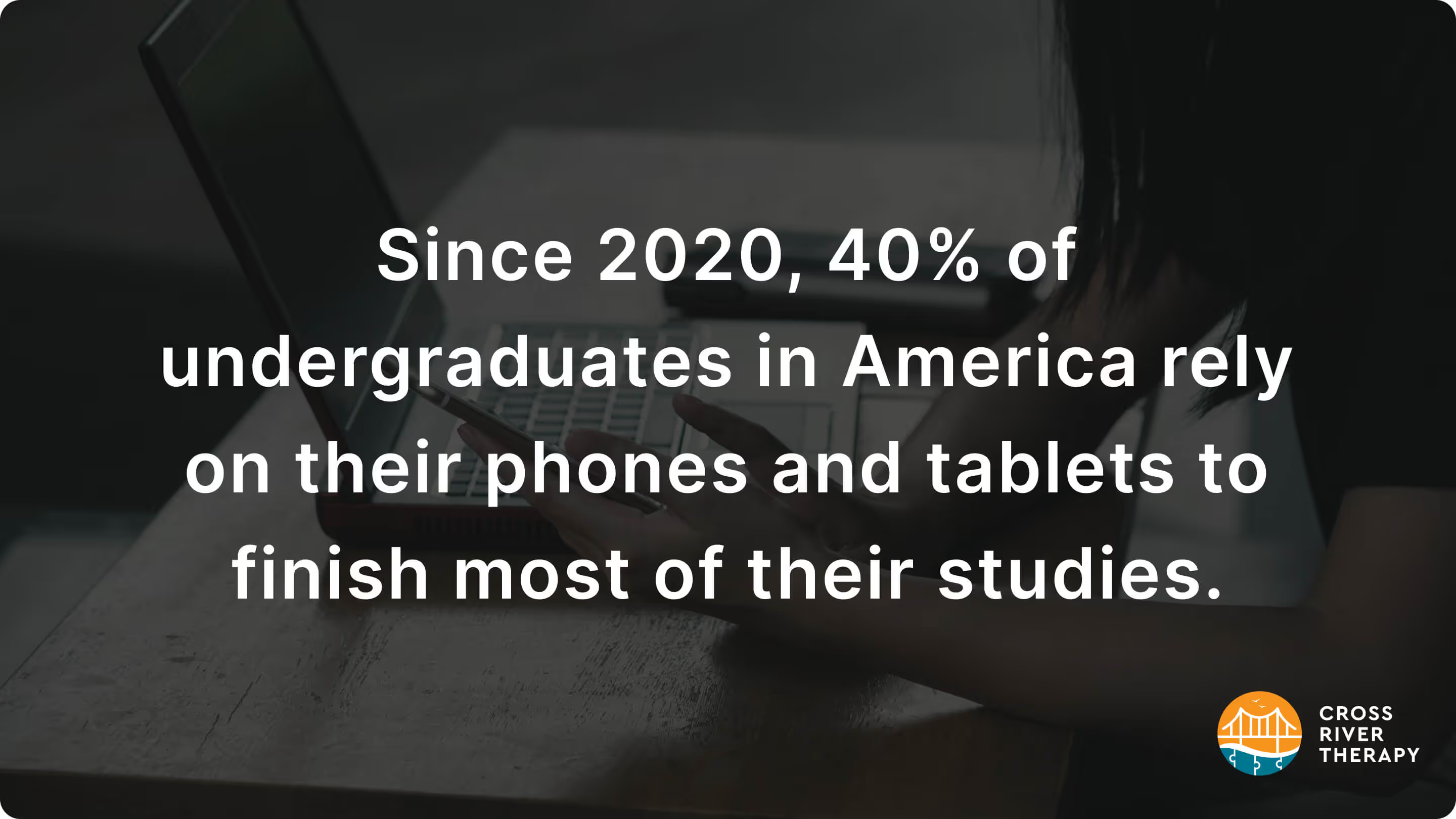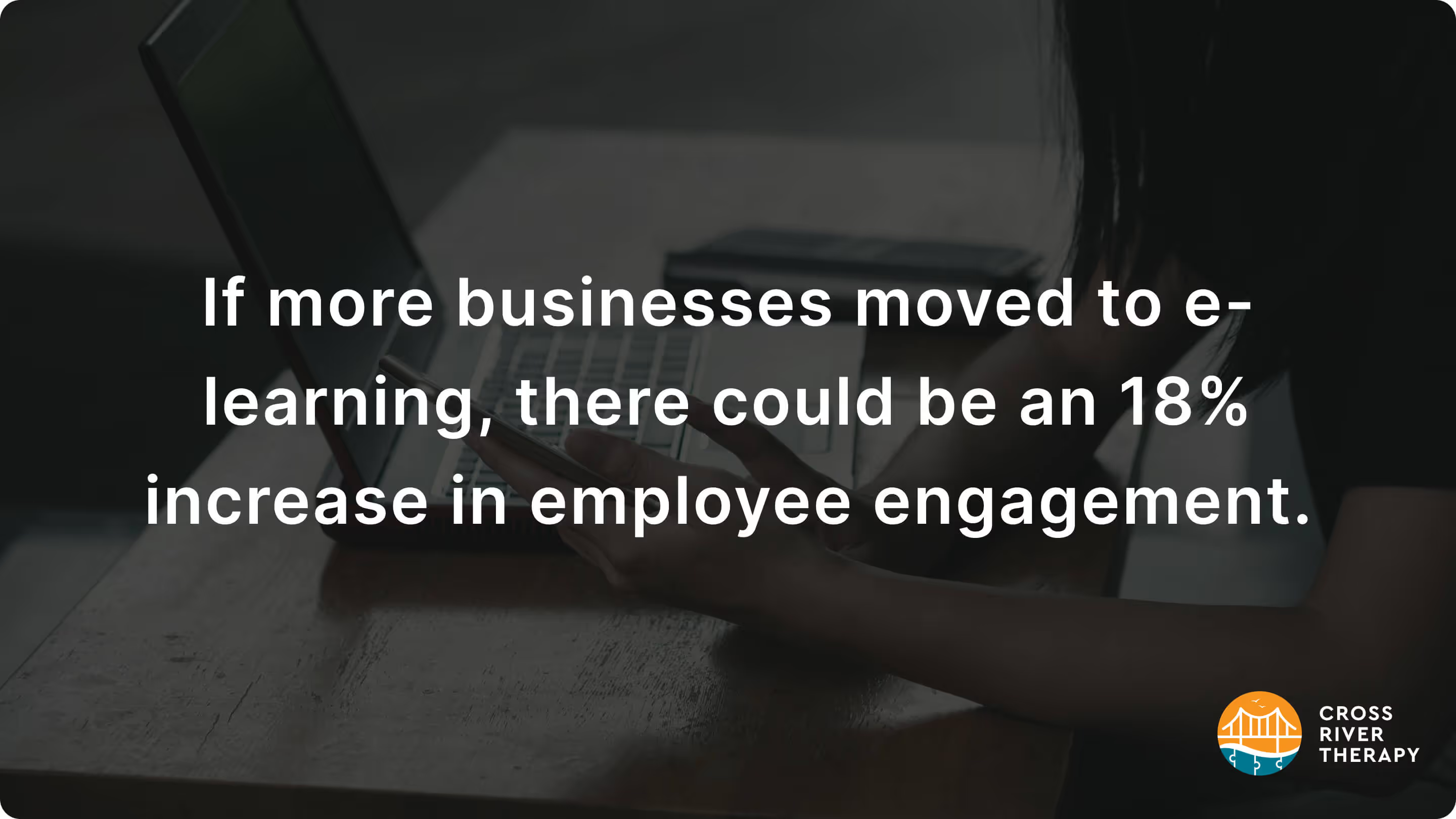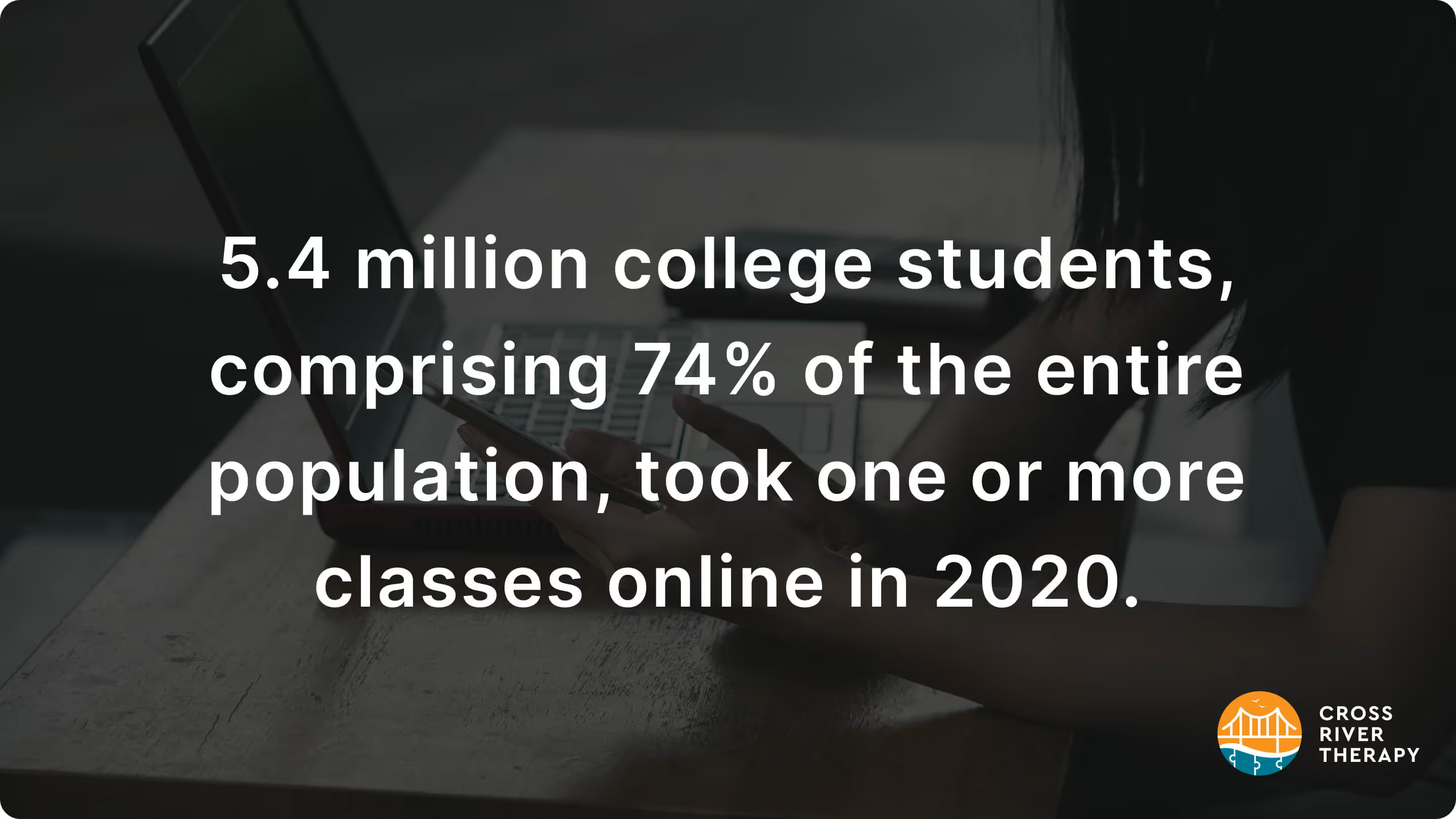47 E-Learning/Online Learning Statistics
Did you know that e-learning increases retention rates by 25% to 60%?

Top 10 E-Learning Statistics
- Worldwide, the e-learning market size is expected to be worth $325 billion by the year 2025.
- 77% of American corporations used e-learning in 2017, but 98% of them put it within their practices in 2020.
- The American e-learning industry is anticipated to increase growth by $12.81 billion by 2024.
- Online learning increases retention rates of students between 25% to 60%.
- The private e-learning industry is expected to see a monetary increase of $38.09 billion from 2020 to 2024.
- Online learning has shown rises in income for 42% of American companies.
- A set of 2,500 businesses learned that those with online training programs of some sort have a 218% greater revenue for each worker and profit margin increases of 24%.
- After making the switch to e-learning, the tech giant IBM saved about $200 million.
- 2 out of 5 businesses listed in the Fortune 500 are currently using e-learning applications.
- 5.4 million college students, comprising 74% of the entire population, took one or more classes online in 2020.
E-Learning Industry Statistics

- Most of the worldwide global e-learning industry is located in the United States and Europe.
- In Asia-Pacific, the e-learning industry is anticipated to grow in popularity by 11% by the year 2026.
- In Asia, the e-learning market will surpass $90 billion by the year 2026.
- The greatest amount of users relying on remote learning in 2021 was from the United States.
- Since 2021, Ireland has had the largest amount of people within the European Union that are actively taking online courses.
- Almost 4,000 colleges and universities in the US have adjusted to e-learning since 2020.
- In 2020, 63% of colleges and universities made large investments in using and promoting e-learning.
- 75% of American schools are making plans to conduct all educational operations online since 2021.
- About 33% of university students are currently taking at least one online course.
- Since 2020, 40% of undergraduates in America rely on their phones and tablets to finish most of their studies.

General E-Learning Statistics

- Worldwide, the e-learning market is expected to be worth $325 billion by the year 2025.
- Worldwide markets showing 30% yearly growth in their market increases are all located in Asia, including Thailand, China, India, and the Philippines.
- From 2020 until 2025, the e-learning market will have a 200% increase in usage.
- Asia is forecasted to have a 20% yearly rise in revenue in the e-learning market.
- In 2020, mobile e-learning grew up to $38 billion. Yet between 2017 and 2022, growth is predicted to rise as high as $6 billion.
- Through greater use of scheduled learning, the e-learning market was expected to decrease in 2021.
- Some of the leading innovators paving the way for virtual classes can be found in companies making improvements in augmented reality and virtual reality, with $300 million in revenue growth since 2020.
- In 2018, microlearning, a smaller version of e-learning, made up 69.7% of e-learning instances.
- Up to 60% of web users have attempted e-learning at some point. This is due to the comfort of using it at their discretion.
- 50% of students and 80% of businesses have relied on online learning applications.
- Web learning accounts for 40% to 60% less time spent by workers and students than ordinary learning methods take.
- Most businesses are using e-learning more than ever before, with 42% of organizations witnessing an increase in revenue for doing so.


- If more businesses moved to e-learning, there could be an 18% increase in employee engagement.
- The Europeans Higher Education Area has 48 nations that are seeking e-learning alternatives for boosting the way students learn.
- The retention rate of people that use e-learning is between 25% and 60%, face-to-face tutoring has a retention rate between 8% to 10%.
- Compliance training is done by 28% of companies through e-learning or online training programs.
- 75% of schools in 2021 have plans to increase their online operations. Before this, 57% of American students relied on digital tools to complete lessons. 45% of them were children in elementary school and 64% were in middle school. 63% were high school students.
- 80% of schools buy or plan to buy more technology for their students, which includes e-learning materials.
- 98% of colleges and universities have moved classes online since 2020.
- Before 2020, 19.5% of undergraduate students took one or more online courses.
- 49% of college professors view online learning in a favorable light.
- Since 2020, up to 98% of learning at the corporate level is done through online learning.
- Students have boosted their ability to take in 25% to 60% more information through the use of e-learning.
- A 30% rise in failing grades is due to some students using e-learning.
- 25% to 33% of students don't have the tools needed to access e-learning resources, creating a divide between social classes and income.

E-Learning Trends

- The worldwide e-learning industry is set to reach $457.8 billion by the year 2026.
- 2 out of 5 Fortune 500 organizations use e-learning.
- 70% of students believe online classes are more useful than going to classes the traditional way.
- Online learning can potentially help students take in up to 60% more information.
- In 2020, only 2% of US organizations didn't rely on e-learning.
- Up to 90% less energy and 85%, less carbon dioxide emissions have been accounted for the higher use of e-learning on college campuses.
- E-learning has boosted incomes for 42% of American businesses.
- Online learning boosts the performance of employees by 15% to 25%, according to experts in the medical field.
Online Learning vs. Face-to-Face Learning Statistics
- Retention rates are boosted by 25% to 60% due to online learning.
- Retention rates of face-to-face learning boosted learning by only 8% to 10%. This is due to students having more control over the way they learn.
- A recent study found that providing online learning courses leave less of a carbon footprint, using 90% less energy consumption and putting out 85% fewer carbon emissions per individual than face-to-face training does.
- There are 48% of undergraduate and graduate students feel that e-learning is as effective as face-to-face learning.
- In late 2020, about 75% of university students took one or more college courses through e-learning tools.
- 46% of college students took their online entirely online.
- There 29% of students took some college courses online, but not all.
- Up to 26% of students didn't take any college courses on the internet, relying on instead on face-to-face instruction.
- Online learning was approved by 37% of students, who feel that it's better than taking face-to-face courses.
- Only 15% of students thought that online courses weren't impactful.
- 30% of undergraduates and 42% of graduate students prefer e-learning courses over in-person learning.
- There is an average of 25% to 60% of students who can retain more knowledge when taking courses online. Face-to-face learning is between 8% and 10%.
- 40% to 80% less time is needed in teaching students online than doing so in a traditional classroom setting.
- In 2020, there were 5.4 million college students that took one or more online courses.

- The rates of completing a course online are lower for students by rates of up to 22%.
- Online learning has seen an increase in failing grades for some students taking middle school classes.
- 98% of students with disabilities have had failing grades when taking courses online.
- More than 1 out of 10 colleges have entirely online-based courses.
- Online colleges have a student body numbering 2.8 million people.
- For online colleges, the average cost for every credit hour is $516.
- When fees are included, 54% of colleges and universities have students taking online courses paying more to attend courses than face-to-face students spend.
- 1 out of 3 teachers has a difficult time preparing for work in a traditional classroom setting.

- In annual reportings, 95% of college alumni suggested online learning over face-to-face learning.
- Up to 43% of school administrators agreed to move forward with high rates of remote e-learning options for students to use after the COVID-19 pandemic.
- About 75% of college undergraduates took one or more courses through an online application, though 71% of graduate students did the same.
- 76% of students attending four-year colleges and universities took one or more courses online, while 69% of students at a two-year took online courses.
- 77% of students attending public universities take at least one e-learning course. However, 68% of private college students took at least one course online.

References
Recent News
Related articles
.avif)
100+ YouTube Statistics, Facts & Demographics
In 2023, YouTube has over 2.5 billion monthly active users.

39 Teacher Statistics And Demographics
Find the most up-to-date teacher demographics and statistics that'll surprise you.

Twitter Statistics for Social Media Enthusiasts [2024]
Explore compelling twitter statistics, user demographics, content engagement, and future predictions.
.avif)
89 TikTok Statistics, Facts & User Demographics
New TikTok statistics show that TikTok has quickly become one of the most popular social media platforms, with users spending an average of 52 minutes per day scrolling through videos.

Key Tinder Statistics You Need to Know
Dive into the world of Tinder statistics - revealing insights on user demographics, engagement, and global trends.
.avif)
49 Telehealth Statistics & Telemedicine Trends
Telehealth statistics show that the use of virtual care is 38 times higher than before the COVID-19 pandemic.

Teacher Salary By State: Highest-Paid Teachers By State
Today we'll breakdown a teacher's salary by state, as well as the highest-paid teachers by state.

121 Social Media Addiction Statistics Worldwide
Did you know that around 70% of teens and young adults in the US have a social media addiction?

57 Scholarship Statistics, Facts & Demographics
Did you know over 1.7 million scholarships are awarded annually? Keep reading to find more scholarship statistics.

Average Screen Time Statistics & Facts (Usage)
Did you know people spend 6 hours 58 minutes on screens everyday? Find more screen time statistics below.

59 Physical Therapy Statistics, Facts & Demographics
There are 578,565 people employed in the physical therapy industry in the US as of 2022. Find more physical therapy statistics and facts below.

Spotify Statistics: 79+ Intriguing Consumption Statistics in Music
Dive into the evolution of music with intriguing Spotify statistics; from user engagement to financial performance.

